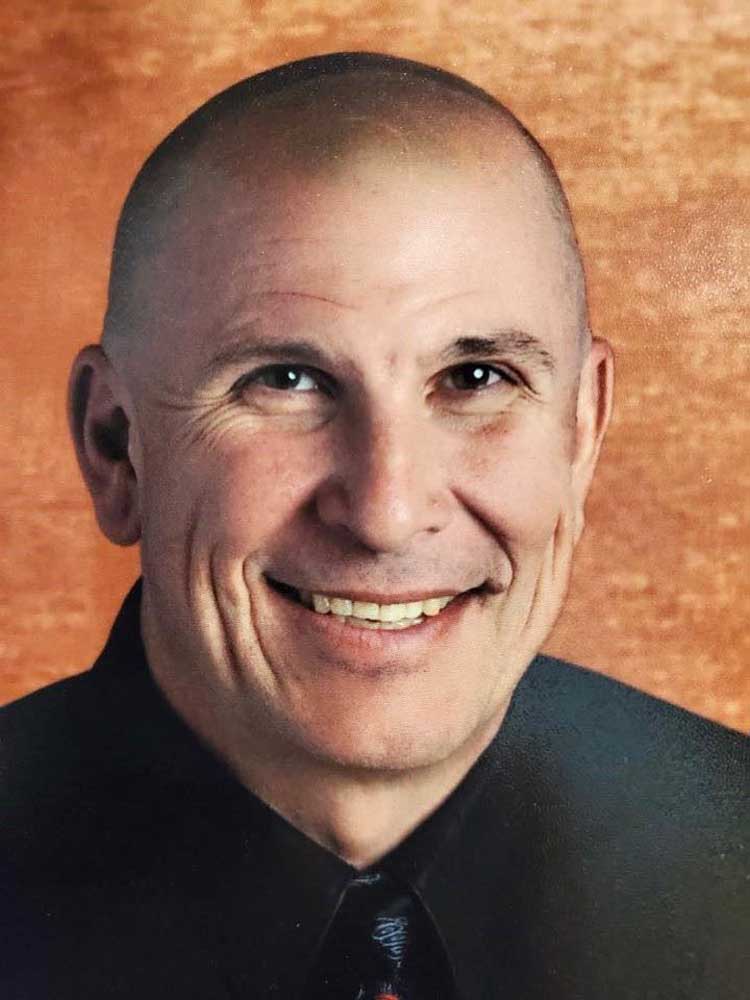Losing a leg, gaining a life: Four amputation surgeries on Ruth Frieboes’ right leg failed, but the fifth, she says, ‘gave me my life back’
Published 7:00 am Friday, May 17, 2024

- Wallace
When a doctor first mentioned the possibility of amputating Ruth Frieboes’ right leg, Frieboes thought he was talking about lunch meat.
Frieboes, who has lived in North Powder since 1977, misheard the physician.
She chuckles as she tells the story, 12 years after the conversation.
And five amputation surgeries later.
The doctor said “below the knee.”
“I thought he said bologna,” Frieboes, 64, said, giving the word its usual pronunciation — “baloney.”
The idea of losing part of her leg was inconceivable.
“I was in complete shock at that point,” Frieboes said.
On Sept. 6, 2012, a surgeon amputated her leg just above the knee.
Frieboes was afflicted by a rare condition — complex regional pain syndrome — that she first noticed in 2009 but wasn’t diagnosed for several years.
Her leg was, in effect, dying.
It became so engorged with fluid that it scarcely resembled a human limb.
Frieboes, who hiked frequently in the Elkhorn Mountains with her husband, John, struggled to walk even short distances.
Although she couldn’t imagine living without one leg, Frieboes finally came to understand, after meeting with dozens of doctors during the preceding three years, that she had no choice.
“If I hadn’t lost my leg, I would have lost my life,” she said.
But even as she accepted that amputation was necessary, Frieboes didn’t know — could not have known — the 2012 surgery in a Seattle hospital would be only her first.
That four more times — in 2014, 2016, 2017 and 2023 — she would lie on a hospital bed while surgeons cut away a bit more of her leg, a terrible series of measurements in centimeters, a progression toward her hip that began to seem inevitable.
The subsequent surgeries happened because Frieboes never completely recovered from the previous procedure. Each time, doctors had to, in effect, start over, removing more of her leg to ensure there was healthy tissue at the stump.
Prosthetics would regularly slide off when she tried to walk.
The remnants of her femur veered to the side, like a bent shock absorber on a pickup that has traveled many miles of punishing terrain.
“Every time I took a step it felt like my pelvis was going to break,” Frieboes said. “It was exhausting.”
New bone that formed at the stump ended up severing muscle.
Whenever she wore the prosthetic, blisters would form around the stump.
She described her walking gait as “weeble-wobble.”
Frieboes didn’t expect to resume daylong hikes, to be sure.
But she couldn’t realize even her modest goals.
“I just wanted to walk,” she said.
After the fourth amputation, in April 2017 in Indianapolis, less than 13 months after the previous operation, Frieboes continued to struggle with her prosthetic, and with pain.
“I could walk, but I couldn’t live like that,” she said. “It’s such a mental thing.”
Her search for a solution took her to Virginia, Kentucky, Boise.
But when doctors in March 2023 suggested yet another amputation, Frieboes felt trapped.
“No way I’m going to do another surgery and have it fail,” she said.
Yet neither could she face a future confined to a wheelchair or having to rely on crutches.
Then she met with a doctor who said the word that changed everything.
It’s a long word, and, to anyone who isn’t an expert in orthopedic surgery, likely a strange word.
But for Frieboes it’s a word as sweet as anything a poet ever penned.
Osseointegration.
And it didn’t just add to her vocabulary.
“It changed my world completely,” Frieboes said. “It gave me my life back.”
A different kind of surgery
It wasn’t a new word to Frieboes.
She first heard about osseointegration four or five years earlier.
She read accounts from patients who had undergone the procedure.
But all of those happened outside the United States.
The federal Food and Drug Administration had yet to fully approve the procedure.
Frieboes was intrigued because osseointegration had the potential to eliminate, or at least significantly reduce, the troubles that had plagued her after each of her four amputations.
Here’s the major difference between the two surgeries:
With osseointegration, the surgeon inserts a titanium anchor rod into the bone of the amputated limb — the right femur, in Frieboes’ case.
The prosthetic, rather than attaching to the stump through what’s known as a “bucket” — a potentially unstable and uncomfortable junction, as Frieboes discovered — connects directly to the implant.
This metal-to-metal link includes a clamp that resembles the quick-release mechanisms that attach wheels to mountain bikes.
Because the titanium rod extends through the remnant bone, the prosthetic becomes, in effect, an extension of the bone rather than a separate limb.
But even as Frieboes struggled with her prosthetic after her fourth surgery, osseointegration seemed an unlikely, if not unreachable, option.
During a medical conference she learned that she could possibly have the surgery done in Australia.
For $120,000 and a three-month stay Down Under.
Frieboes couldn’t afford that.
But then, just a few weeks after a prosthetist in Boise suggested Frieboes consider a fifth amputation, she learned a Portland-area surgeon, Dr. Stephen Wallace of Summit Orthopaedics, was looking for potential candidates for osseointegration.
She met with Wallace on March 31, 2023.
It was the same day her great-granddaughter was born.
(It was the first of two milestones Frieboes would share with the little girl.)
Frieboes said Wallace was excited. He told her she was an “excellent candidate” for the surgery.
But before she could submit her diminished leg to the surgeon’s scalpel for the fifth time, there was paperwork.
Lots of paperwork.
“That day (March 31, 2023) we started the FDA approval process,” Frieboes said.
She said she was the first person in the Pacific Northwest to pursue osseointegration surgery in the region.
The procedure was finally scheduled, two days after Christmas 2023 at Portland’s Legacy Emanuel hospital.
A little more than a month later, on Feb. 8, 2024, doctors told Frieboes she could put weight on her new prosthetic.
Very little weight — 20 pounds of pressure for no more than 20 minutes.
But even those tentative steps were a revelation.
The pain that had plagued her every step with the other prosthetics did not recur.
On March 15 she started walking with the aid of a cane.
On Easter Sunday she set the cane aside and strode with confidence.
But slowly, in deference to the little girl who stood beside her.
Frieboes’ great-granddaughter, who celebrated her first birthday that day, also took her first steps that day.
The pair started their own separate journeys that day, hand in hand.
The first signs of trouble
That first walk was a landmark moment in an ordeal that started a decade and a half earlier.
It should have been just another wonderful day in the mountains.
Frieboes and her husband were hiking, as they often do.
She noticed the lower part of her right leg was splotchy red, rather like a rash.
When she stopped to tie her bootlace she felt her leg. The skin felt strangely loose. When they returned to North Powder, her leg was swollen.
Frieboes, who worked at the North Powder School, continued to hike.
Her leg never returned to normal.
But a diagnosis proved elusive.
Frieboes spent a month at the Mayo Clinic in Minnesota in 2011 with no resolution.
The situation became acute — and dangerous — in the spring of 2012.
Her right foot swelled so severely it hardly resembled a human foot.
Frieboes said her doctor was “shocked” when he saw her foot.
It was so laden with fluid that she couldn’t lift the foot without using her arms.
“I felt like I was dying,” she said.
At 5-foot-9, she weighed a scant 90 pounds.
She traveled to Portland. More doctors examined her. All were mystified.
Doctors drained the fluid, dressed the wound and sent Frieboes home to North Powder.
Although her condition wasn’t improving much, she never contemplated the possibility that she would lose her leg.
“No one had ever mentioned amputation,” she said.
By July 2012 her leg was, as she puts it, “falling apart.”
She traveled to the University of Washington in Seattle.
More doctors arrived — they came in groups of six, like teams of athletes, 30 or so in all.
It was then that Frieboes mistook “below the knee” for “bologna.”
Her first amputation happened Sept. 6, 2012.
The recovery, both physically and mentally, took months.
But Frieboes accepted the immense change in her life.
She healed.
On the first anniversary of the surgery, she wanted to celebrate in only one way.
She wanted to hike to Twin Lakes, the pair of alpine tarns formed in the depression gouged from the Elkhorn Mountains by Ice Age glaciers.
It was a cold and windy day even though two weeks of summer remained. It is the shortest and least trustworthy of seasons at 8,000 feet, where the Elkhorn Crest Trail runs to a saddle that overlooks the lakes.
“When I saw the lake I lost it,” Frieboes said, her eyes glistening as she recalls the magnitude of that moment, when she realized that even without most of her right leg she still could see the places she most treasured.
She remembered the moments of despair, when she was returning from another doctor’s appointment in Boise and she looked up at those mountains and thought, “I’m never going to be back up there.”
But she was.
A couple of mountain goats even peered over a rocky knob while she gazed down at the lakes.
After that first anniversary, Frieboes and her husband always celebrated the day in some fashion.
One year they fly fished on the Yellowstone River in Montana.
That was challenging, Frieboes said. Balancing on a prosthetic leg in a chilly, fast-flowing river is hard.
She had to attach weights to her prosthetic foot to hold it against the current.
“After that day I hurt head to toe,” she said. “Including my cheeks, from smiling so much.”
She learned to shoot a pistol for self-defense.
“It’s not like I can outrun anyone,” she said with a laugh.
She took a glassblowing class one year.
On another anniversary she rode the Wallowa Lake Tram and walked the trails.
“I forced myself to stay active,” Frieboes said. “I collect positive quotes. You can live two different ways. You can be upset about it and be sad, but it takes more energy to do that.”
A diagnosis — and a brighter future
Several years ago doctors finally diagnosed the underlying cause — complex regional pain syndrome — CRPS.
It is a neurological disorder that typically arises after a person has sustained an injury, including, in some cases, after a limb is amputated, Frieboes said.
In her case, though, the condition seemed to arise spontaneously, well before her first surgery.
Frieboes said her research into CRPS revealed the malady can cause more severe pain than any other chronic condition.
She can attest to that.
CRPS causes nerves to, in effect, overreact. The nerve signals, which the brain interprets as evidence of tissue damage, cause inflammation, which normally promotes healing. But in Frieboes’ case this nerve-provoked reaction continued until it had the opposite effect, damaging rather than healing her leg.
About four years ago, after her fourth amputation, Frieboes said she started to have CRPS symptoms in her left, intact, leg.
But because doctors had diagnosed her condition they were able to treat the disorder. Several years ago they installed an electric device in her spinal cord to stimulate the nerves and ideally prevent nerve messages from causing issues with her leg.
Then, during the Dec. 27, 2023, surgery in Portland, surgeons used a process known as targeted muscle reinnervation that reroutes injured nerves. Frieboes said the procedure basically gives nerves “something to do,” which prevents them from sending false signals that can lead to inflammation, chronic pain and the other issues that led to the loss of her right leg.
Frieboes still suffers from pain due to CRPS.
But since her surgery in the final week of 2023, her outlook has changed dramatically.
So have her capabilities.
After Wallace cleared her to walk without a cane at the end of March, Frieboes’ goal during April was to take a walk every day.
She ended up covering 51.5 miles during the month.
“It used to be that I could take 1,500 steps at best, and I would be in tremendous pain,” Frieboes said, her eyes brimming with tears as she remembers the despair, the terrible thought that this was to be her plight for the rest of her life.
Osseointegration didn’t just reward Frieboes with renewed mobility, though.
The new prosthetic, with its direct connection to her bone, “feels like my leg,” she said.
She can distinguish, through the bottom of her prosthetic foot, between the textures of grass and pavement, tile and carpet.
That hadn’t happened since her first amputation almost a dozen years ago.
It’s hardly surprising, then, that Frieboes has become an advocate for osseointegration.
“My goal is awareness,” she said.
She joined online amputee support groups several years ago, and she wants others to know about a procedure that could potentially help them as dramatically as it has done for her.
She is a peer mentor for the Amputee Coalition of America.
“I struggled for 11 years, and so much of my time as an amputee has been recovering,” Frieboes said.
But now, after so many years, so many surgeries and so many disappointments, she can contemplate the future not with fear, but with excitement and gratitude.
She and John are planning spring hikes.
And as the snow continues its seasonal retreat up the slopes of the Elkhorns, the trail to Twin Lakes will again be revealed.
Soon she will stand again in that saddle and gaze down at her favorite place, its deep blue water only recently free of ice.
And this time, unlike in 2013, she intends to descend the switchbacks and stand on the lakeshore, close enough to hear the water lapping against the sedimentary stone.
“I don’t want to sit still.”
“If I hadn’t lost my leg
I would have lost my life.”
— Ruth Frieboes
Surgeon calls Frieboes ‘a rock star’
For Dr. Stephen Wallace, Ruth Frieboes isn’t just a patient.
“She’s a rock star,” said Wallace, the Lake Oswego surgeon who performed the osseointegration surgery on Dec. 27, 2023, that, in Frieboes’ words, “gave me my life back.”
Wallace said Frieboes was the first person in the Pacific Northwest to have the surgery in which the surgeon implanted a titanium anchor through the remnants of Frieboes’ right femur and extending to her pelvis.
(Another type of osseointegration involves screwing an anchor into the remnant bone, Wallace said.)
Since then, he said he has done the procedure on several other patients.
Because the Food and Drug Administration has not formally approved the surgery, it can be done on a case-by-case basis, which involves a considerable amount of paperwork.
The process took about nine months in Frieboes’ case.
Although osseointegration isn’t appropriate for all amputees, Wallace said the surgery, as Frieboes is eager to attest, can give patients much more mobility, but with less pain, than a traditional procedure and prosthetic limb that attaches to the stump rather than to an anchor attached to bone.
That “direct skeletal connection” gives patients sensations absent with other prosthetics, Wallace said, including the ability to feel different textures as they walk.
Wallace said Frieboes, who underwent four amputations on her right leg before the osseointegration surgery, inspires other amputees.
She inspires him, too.
“She’s such a positive person, with everything she’s gone through,” Wallace said. “It’s just a joy seeing her every time.”
Their next meeting is likely to happen not in the antiseptic atmosphere of a doctor’s office or a hospital.
Wallace is eager to accept Frieboes’ offer to travel to Eastern Oregon and accompany her and her husband, John, on a hike in the mountains.
It’s Ruth’s favorite pastime.
And sometime this summer, he looks forward to watching her clamber up a rocky trail, and knowing that he helped make it possible.
“I’m extremely happy for Ruth,” he said.
— Jayson Jacoby





